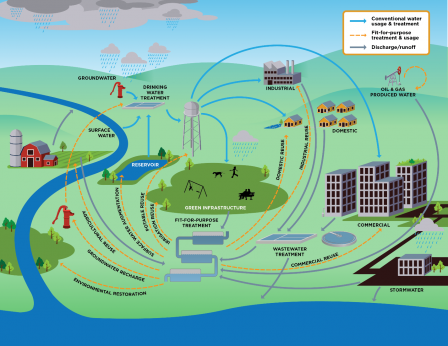Basic Information about Water Reuse
Basics of Water Reuse
Water reuse (also commonly known as water recycling or water reclamation) reclaims water from a variety of sources then treats and reuses it for beneficial purposes such as agriculture and irrigation, potable water supplies, groundwater replenishment, industrial processes, and environmental restoration. Water reuse can provide alternatives to existing water supplies and be used to enhance water security, sustainability, and resilience.
Water reuse can be defined as planned or unplanned. Unplanned water reuse refers to situations in which a source of water is substantially composed of previously-used water. A common example of unplanned water reuse occurs when communities draw their water supplies from rivers, such as the Colorado River and the Mississippi River, that receive treated wastewater discharges from communities upstream.
Planned water reuse refers to water systems designed with the goal of beneficially reusing a recycled water supply. Often, communities will seek to optimize their overall water use by reusing water to the extent possible within the community, before the water is reintroduced to the environment. Examples of planned reuse include agricultural and landscape irrigation, industrial process water, potable water supplies, and groundwater supply management.
Types of Water Reuse
Sources of water for potential reuse can include municipal wastewater, industry process and cooling water, stormwater, agriculture runoff and return flows, and produced water from natural resource extraction activities. These sources of water are adequately treated to meet “fit-for-purpose specifications” for a particular next use. "Fit-for-purpose specifications” are the treatment requirements to bring water from a particular source to the quality needed, to ensure public health, environmental protection, or specific user needs. For example, reclaimed water for crop irrigation would need to be of sufficient quality to prevent harm to plants and soils, maintain food safety, and protect the health of farm workers. In uses where there is a greater human exposure water may require more treatment.
Uses for Recycled Water
-
Irrigation for agriculture
-
Irrigation for landscaping such as parks, rights-of-ways, and golf courses
-
Municipal water supply
-
Process water for power plants, refineries, mills, and factories
-
Indoor uses such as toilet flushing
-
Dust control or surface cleaning of roads, construction sites, and other trafficked areas
-
Concrete mixing and other construction processes
-
Supplying artificial lakes and inland or coastal aquifers
-
Environmental restoration
Water Reuse Regulations in the United States
EPA does not require or restrict any type of reuse. Generally, states maintain primary regulatory authority (i.e., primacy) in allocating and developing water resources. Some states have established programs to specifically address reuse, and some have incorporated water reuse into their existing programs. EPA, states, tribes, and local governments implement programs under the Safe Drinking Water Act and the Clean Water Act to protect the quality of drinking water source waters, community drinking water, and waterbodies like rivers and lakes. Together, the Safe Drinking Water Act and the Clean Water Act provide a foundation from which states can enable, regulate, and oversee water reuse as they deem appropriate.

